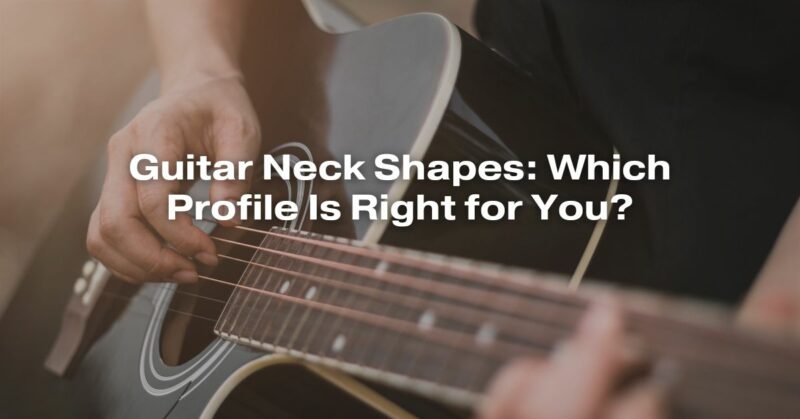The neck of a guitar is often considered its heart and soul. It’s the primary interface between the musician and the instrument, dictating how comfortable and easy it is to play. Guitar necks come in various shapes and profiles, each with its unique characteristics, affecting playability, tone, and overall feel. Choosing the right neck profile is a crucial decision for any guitarist, whether you’re a beginner or a seasoned player. In this comprehensive guide, we’ll explore the most common guitar neck shapes and help you determine which one is right for you.
Why Does Neck Shape Matter?
Before delving into the different neck profiles, it’s essential to understand why neck shape matters. The neck is where your hand makes constant contact with the guitar, making it a critical factor in your playing experience. Here are some key reasons why neck shape is important:
- Comfort: The shape of the neck can significantly impact your comfort while playing. Some players prefer thicker necks, while others prefer slimmer ones, depending on their hand size and playing style.
- Playability: Different neck shapes affect how easy it is to perform techniques such as bending, vibrato, and fast fretting. The right neck profile can enhance your playing capabilities.
- Tone: Surprisingly, the neck shape can influence the guitar’s tone. A thicker neck might resonate differently than a thinner one, leading to variations in the instrument’s sound.
- Personal Preference: Ultimately, the choice of neck shape often comes down to personal preference. What feels comfortable and enjoyable to you is crucial for your musical journey.
Now, let’s explore some of the most common guitar neck profiles:
1. C-Shape
The C-shaped neck profile is one of the most popular and versatile options. It’s characterized by a gentle curve that resembles the letter “C.” This profile offers a comfortable grip and is suitable for a wide range of playing styles. It’s a great choice for beginners as it strikes a balance between thickness and playability. Many Fender guitars, like the Stratocaster and Telecaster, feature C-shaped necks.
2. U-Shape
U-shaped neck profiles are known for their chunky and substantial feel. These necks have a pronounced curve that forms a “U” shape. They provide excellent support for players with larger hands or those who prefer a more vintage, substantial feel. U-shaped necks are commonly found on some vintage Fender guitars, particularly those from the 1950s.
3. D-Shape
D-shaped necks are similar to C-shaped ones but have a flatter back. This design allows for a more comfortable resting of the thumb on the back of the neck, making it a favorite among players who like to play with their thumb over the top of the fretboard. Gibson’s Les Paul and SG models often feature D-shaped necks.
4. V-Shape
V-shaped necks have a distinctive, V-like contour. These necks provide a unique and comfortable grip for players who like to feel their thumb resting against the back of the neck. V-shaped necks are often associated with vintage and custom-built guitars.
5. Slim-Taper
Slim-taper necks are characterized by their thin and fast profile. They are designed for players who prioritize speed and ease of fretting. These necks are popular in the world of shredding and metal music. You’ll commonly find slim-taper necks on guitars from brands like Ibanez and Jackson.
6. Modern “C”
The modern “C” profile is a variation of the classic C-shape but with a flatter back and slightly thinner dimensions. This profile is ideal for players who want the comfort of a C-shape but with a more contemporary feel. Many modern Stratocasters and Telecasters feature this neck shape.
7. Flat Oval
Flat oval necks provide a balanced feel between a slim-taper and a traditional C-shape. They are a great choice for players who want a comfortable grip without sacrificing speed. These necks are found on various guitars and are suitable for various playing styles.
How to Choose the Right Neck Shape
Choosing the right neck shape ultimately depends on your personal preferences and playing style. Here are some tips to help you make an informed decision:
- Try Before You Buy: Whenever possible, play different guitars with various neck profiles to get a feel for what suits you best. Comfort is subjective, and what works for one player may not work for another.
- Consider Hand Size: If you have smaller hands, you may find slimmer neck profiles more comfortable. Conversely, if you have larger hands, you might prefer thicker necks for better support.
- Playing Style: Consider the music you play. If you’re into fast, intricate solos, a slim-taper neck might be your best bet. If you’re more into rhythm and chord work, a comfortable C- or D-shape might be ideal.
- Vintage vs. Modern: Vintage-style necks, like U- and V-shaped profiles, can provide a classic feel, while modern necks offer improved playability for contemporary styles.
- Thumb Placement: Think about where you like to place your thumb while playing. If you like to wrap your thumb over the fretboard, a D-shaped neck might be suitable.
- Guitar Weight: Consider the overall weight of the guitar. Heavier guitars with thicker necks can cause fatigue during extended playing sessions.
- Experiment: Don’t be afraid to experiment and step out of your comfort zone. Trying different neck profiles can lead to new playing experiences and styles.
In conclusion, the choice of guitar neck shape is a highly personal one. It’s essential to balance comfort, playability, and the style of music you intend to play. Take the time to explore various neck profiles, and you’ll likely discover the perfect match that enhances your playing experience and helps you unlock your full musical potential. Whether you gravitate towards the classic feel of a vintage neck or the speed of a modern slim-taper, the right neck profile can make all the difference in your guitar journey.


